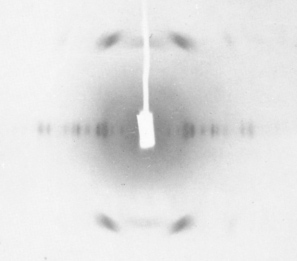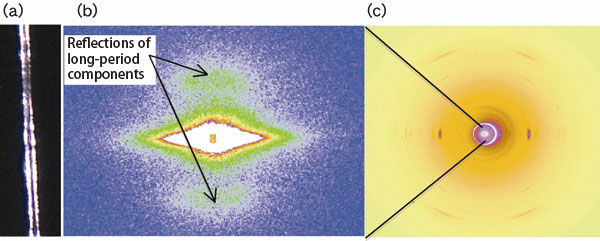Soft Matter
Exploring Nano- and Meso-Structures of Polymers and Organic Surfaces

Possibility of Polymers as Functional Materials
Soft matter is organic compounds composed of molecules in which numerous atoms (mainly carbon, hydrogen, oxygen, and nitrogen) are linked by covalent bonds. Soft matter includes polymers, plastics, liquid crystals, micelles, etc. Polymers include proteins, DNA, polysaccharides, as well as natural rubbers and fibers (e.g., natural silk and wool). Soft matter is utilized in diverse materials such as automotive parts, household goods, electronics (e.g., LCD televisions and mobile phones), and biomedical products, as well as used as films in various fields such as printing, adhesive bonding, and coatings.
The first synthetic polymer, a phenolic resin, was made in the early 20th century. In 1926, Hermann Staudinger, who later won the Novel Prize in Chemistry in 1953, proposed the concept of a polymer, which he defined as a macromolecule of which hundreds to tens of thousands of atoms are linked in a corded form. This concept was accepted by the academic community in 1930, and in 1935, Wallace H. Carothers (DuPont, USA) synthesized nylon,*1 the world's first synthetic polymer that is stronger than silk. Then Ichiro Sakurada (Kyoto University, Japan) and colleagues synthesized Japan's first synthetic polymer, vinylon (polyvinyl alcohol), in 1939.
Polymers are chain-like macromolecules that soften when heated, but maintain their original form at room temperature. This characteristic is called plasticity, which is the word origin of plastic. Hence, polymers have vast potential in practical applications. Paul J. Flory, who received the Nobel Prize in Chemistry in 1974, revealed the relationship between molecular structure and polymeric properties. This discovery advanced the research of polymer physics and chemistry. In the synthetic chemistry of polymers, Michael Szwarc developed living polymerization, which is the basis of Topic 10 (Three-Component Copolymers), to produce polymers with a uniform molecular weight, as well as radical polymerization and polycondensation. Karl Ziegler and Giulio Natta (they shared the Novel Prize in Chemistry, 1963) established the stereoregular polymerization of polyethylene and polypropylene. Figure 1 lists the Nobel Prizes relating to synthetic polymers.
Hence, in the 1970-80s, it was believed that all the necessary techniques for polymerization were known, and research focused on the synthesis (polymerization), structures, and physical properties of polymers. However, around 1980 polymer scientists began examining the possibilities of polymers as functional materials. Hideki Shirakawa (Nobel Prize in Chemistry, 2000) was the first to reveal that polymers, which are primarily insulators, will become conductors if they contain successive conjugated double bonds in their molecular structures, and he discovered a synthetic method to fabricate conductive films using such polymers. His pioneering work has led to the development of conductive films used in mobile phones, and has resulted in the development of organic thin film transistors (TFTs) [see Topic 9 (Analysis of Nanosurfaces)]. Additionally, studies on functional polymers such as photofunctional polymers and organic EL (which have transparency, fluorescence, photodiscoloration, nonlinear optical effect, and optical responsivity), biopolymers, biomedical polymers, and micelles have advanced.
Accordingly, new polymers with various structures can now be synthesized based on molecular design by modifying nanoscale molecular linkages. Thus, the development of innovative analysis techniques to determine the molecular or higher-order structures of these polymers is highly anticipated.
Synchrotron X-rays - Powerful Weapons for Manufacturing
Two approaches are available to determine the structures of materials: microscopy and diffraction/scattering measurements.*2 In the 1950-60s, the primary method to determine polymer conformations was X-ray structure analysis of crystalline polymers. However, advances in microscopy technologies in the 1980-90s produced atomic force microscopes, optical near field microscopes, and confocal microscopes, as well as transmission and scanning electron microscopes, which significantly developed surface observation techniques on the micron- to nano-scales. Although powerful, these microscopes can only explore a small region, but not the entire object. Moreover, these techniques are mainly used for surface observations, and the internal atomic or higher-order structures of materials or the rapid movements of materials cannot be visualized. This is where the advantages of X-ray and light diffraction and scattering measurements for structural analyses shine through.
Visible light has a wavelength greater than 400 nm (1 nm = 10-9 m). In contrast, X-rays have a wavelength on the order of 0.1 nm, which allows the crystal structures of atoms and molecules to be observed on the nanoscale level. Furthermore, small angle X-ray scattering (SAXS) can reveal the structures of various non-crystalline materials as well as non-uniform structures of materials. Topic 7 (Nano-Oriented Crystal Polymers) covers the first direct observation of the nucleation processes in polyethylene nanocrystals using highly brilliant synchrotron X-rays, while Topic 10 (Three-Component Copolymers) reports the discovery of quasicrystals on the order of 100 nm in size by SAXS measurements. Realization of a drug delivery system by identifying nanoparticles is covered in Topic 8 (Supramolecular Assembly). Topic 9 (Analyses of Nanosurfaces) would not be possible without third-generation synchrotron radiation available at SPring-8, which is highly brilliant and directional. In addition to enabling structures within a few nanometers from the surface of a crystal to be detected using grazing incidence X-ray diffraction (GIXD) within the critical angle of total reflection, third-generation synchrotron radiation can also reveal the local structures of materials in a small region (~10 μm) using microbeams (MBs). These are two reasons why synchrotron radiation at SPring-8 is crucial for soft matter research (Fig. 2).
Figure 3 shows an X-ray crystallographic image of vinylon using cutting-edge technology in the 1950s. The image was recorded by combining several fiber bundles of vinylon and exposing them to X-rays for several hours. Figure 4 is an image of a single ultra-thin fiber (diameter ~15 μm) from the same vinylon sample, which was stored at the Institute for Chemical Research, Kyoto University. The sharp wide-angle [wide-angle X-ray diffraction (WAXD)] and small-angle [small-angle X-ray scattering (SAXS)] diffraction-scattering patterns were acquired at the Advance Softmaterial Beamline (BL03XU: in operation since February 2010) in just 20 sec. It is amazing that SPring-8 can now reveal a detailed structural model of what was only a theoretical model 50 years ago.*3
n summary, synchrotron radiation X-rays are powerful weapons for investigating the secrets of soft matter. SPring-8's X-rays can reveal the structures of materials at the nano- and meso-scales. SPring-8 is awaiting new challenges from researchers in soft matter science and manufacturing science.
*1 Minoru Imoto. 1971. Nylon no hakken [Discovery of Nylon], Tokyo, Japan: Kagaku Dojin.
*2 Takuhei Nose , Kazuyuki Horie, and Toshiji Kanaya, eds. 2006. Wakate kennyusha no tameno yuki-koubunshi sokutei labo guide [Laboratory guide for the measurements of organic molecules and polymers for young researchers], Tokyo, Japan: Kodan-sha.
*3 SPring-8's homepage > Press Release > February 4, 2010
http://www.spring8.or.jp/ja/news_publications/press_release/2010/100202 (in Japanese)

First four are universal research on polymers while the latter two are related to functional polymers.

In manufacturing science, which strives to realize innovative physical properties and functions, SPring-8 can determine the nano- and meso-structures of newly synthesized materials.

(reproduced with permission from Nitta, Isamu ed. 1959. X-sen kesshou-gaku [X-ray crystallography] Tokyo, Japan: Maruzen Company)

a: Single vinylon fiber (diameter ~15 μm).
b: Small-angle X-ray scattering (SAXS) image.
c: Wide-angle X-ray diffraction (WAXD) image.